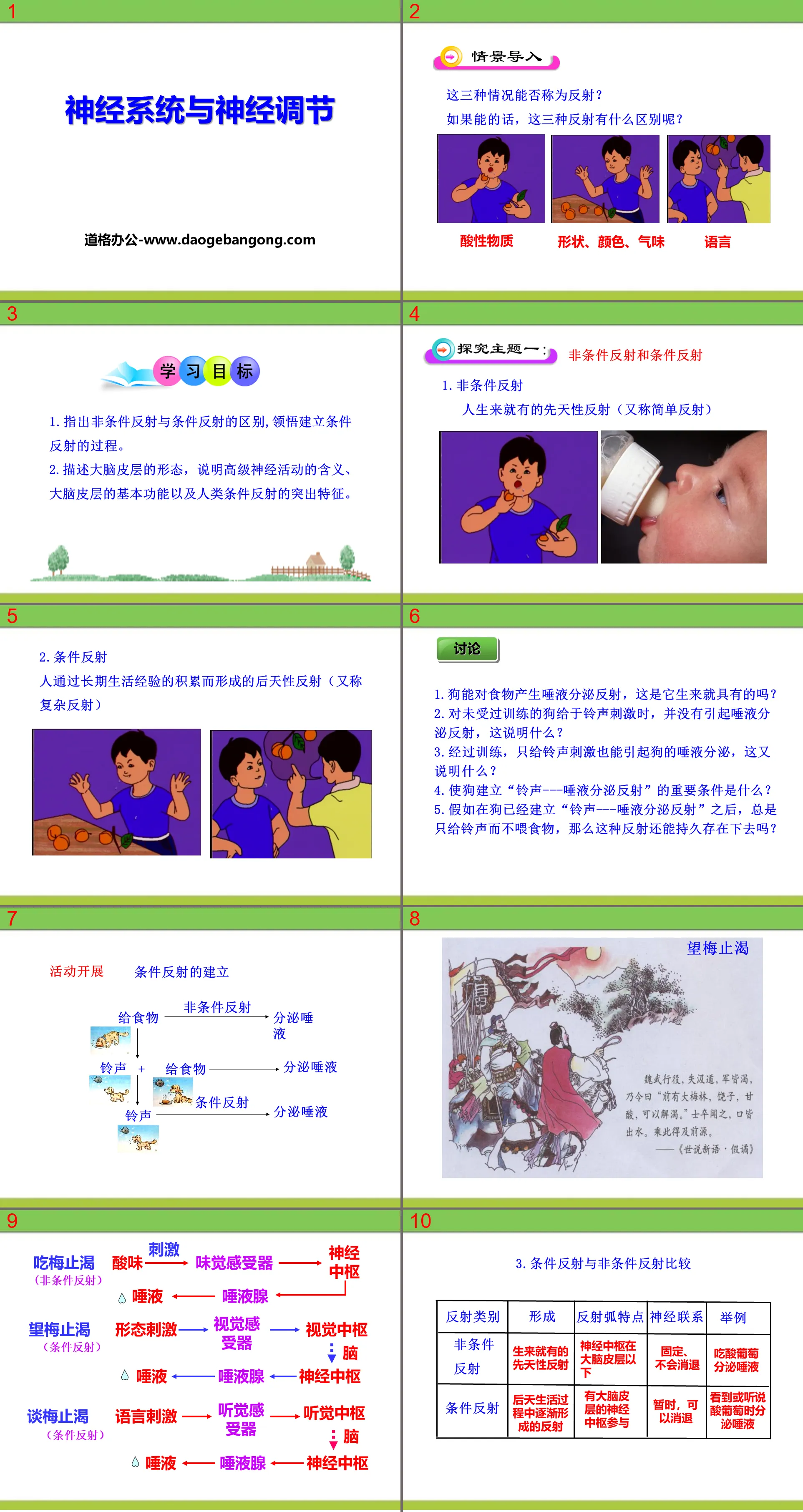People's Education Edition Biology for Grade 8, Volume 1
People's Education Edition Biology for Grade 8, Volume 2
People's Education Edition seventh grade biology volume 1
People's Education Press High School Biology Compulsory Course 2
Beijing Normal University Edition Seventh Grade Biology Volume 2
People's Education Press seventh grade biology book volume 2
Beijing Normal University Edition Eighth Grade Biology Volume 1
Beijing Normal University Edition Seventh Grade Biology Volume 1
Beijing Normal University Edition Eighth Grade Biology Volume 2
Jiangsu Education Edition Seventh Grade Biology Volume 1
High School Biology Compulsory Course 1, published by People's Education Press
Jiangsu Education Edition 8th Grade Biology Volume 1
Jiangsu Education Edition Seventh Grade Biology Volume 2
Jiangsu Education Edition 8th Grade Biology Volume 2

| Category | Format | Size |
|---|---|---|
| Beijing Normal University Edition Seventh Grade Biology Volume 2 | pptx | 6 MB |
Description
"Nervous System and Neuromodulation" PPT courseware
Part One: Situation Import
Can these three situations be called reflections?
If so, what is the difference between these three reflections?
learning target
1. Point out the difference between unconditioned reflex and conditioned reflex, and understand the process of establishing conditioned reflex.
2. Describe the morphology of the cerebral cortex, explain the meaning of advanced neural activities, the basic functions of the cerebral cortex, and the outstanding features of human conditioned reflexes.
Nervous system and neuromodulation PPT, part 2 content: course exploration
Explore theme one
unconditioned reflex and conditioned reflex
1. Unconditioned reflex
Innate reflexes that humans are born with (also known as simple reflexes)
2. Conditioned reflex
Acquired reflexes (also called complex reflexes) formed by people through the accumulation of long-term life experience
discuss
1. Dogs can produce a salivation reflex in response to food. Is this something they are born with?
2. When an untrained dog is given a bell stimulus, it does not induce a salivation reflex. What does this mean?
3. After training, only the sound of a bell can trigger saliva secretion in dogs. What does this mean?
4. What are the important conditions for dogs to establish the "ringing---salivation reflex"?
5. If after the dog has established the "bell---saliva secretion reflex", it only gives the bell but no food, will this reflex still persist?
Nervous system and neuromodulation PPT, part 3: training small animals to establish certain conditioned reflexes
Purpose requirements
1. Experience the practical process of training small animals to establish conditioned reflexes;
2. Further understand the main differences between unconditioned reflexes and conditioned reflexes and the meaning of conditioned reflexes.
Method steps
Please refer to the following example:
1. Prepare several untrained small goldfish;
2. Feed small fish a small amount of food twice a day at a fixed time;
3. Before each feeding, tap the wall of the fish tank 3-5 times with your fingers, and then feed the food.
Observe the reaction of the small fish: initially tapping the wall of the fish tank will cause the small fish to swim away in panic, and feeding will cause the small fish to respond positively to eating; later, when you see the small fish no longer panic after being stimulated by the vibration of tapping the wall of the fish tank , and when just tapping the wall of the fish tank, it will immediately make a "feeding" action. This shows that the small fish has established a conditioned reflex of "feeding" in response to this kind of tapping.
discuss
In the next class, the following content should be discussed in class:
1. Experimental design (including purpose, principle, method, etc.);
2. Experiment implementation process;
3. Record and organize data of experimental results;
4. Experimental conclusion.
Explore theme two
The cerebral cortex is the highest center of the nervous system
1. Position and shape of various parts of the brain
2. Morphological structure of cerebral cortex
The brain is the largest part of the human central nervous system and consists of the left and right hemispheres. There are many winding grooves (concaves) and gyri (convexes) on the surface of the cerebral hemisphere, which makes the actual surface area of the brain much larger than the smooth shape.
3. Main functional areas on the cerebral cortex
The cerebral cortex can receive information from various receptors to form feelings (such as vision, hearing, smell, etc.), and can also send information to lower centers. The cerebral cortex has become the highest-level center that manages overall neuroregulation. Therefore, the cerebral cortex occupies the highest central position, and its physiological activities are called advanced neural activities. Human learning, memory, language, emotion, sleep, etc., are all high-level neural activities.
4. Outstanding features of human conditioned reflexes
Conditioned reflexes are a form of neural regulation that both humans and animals have, but human conditioned reflexes are far richer and more complex than those of animals.
In addition to reacting to specific signals, humans can also react to abstract signals (such as language, text, etc.) and establish conditioned reflexes. This is related to the language center of the human cerebral cortex.
Therefore, being able to establish conditioned reflexes in response to language and text stimulation is the most prominent feature of human conditioned reflexes and is also the essential difference between humans and animals.
Nervous system and neuromodulation PPT, Part 4 content: Class summary
1. Type of reflection
(1) Unconditioned reflex: a basic response to stimuli that is present at birth. No brain involvement is required. Examples: hand withdrawal reflex, knee jerk reflex, salivation after eating, etc.
(2) Conditioned reflex: It is formed by the accumulation of acquired life experience and can adapt to the changing environment. It requires the participation of the nerve center of the cerebral cortex.
Examples: Walking into the classroom when hearing the bell, dancing when hearing the chicken, turning pale when talking about tigers, drawing cakes to satisfy hunger, looking at plum blossoms, salivating while talking about plum blossoms.
Human-specific conditioned reflexes: conditioned reflexes established in response to language and text stimuli. This is also the most prominent feature of human conditioning.
2. Cerebral cortex
(1) Features: The gray matter structure on the surface of the brain is composed of neuron cell bodies. There are many concave grooves and protruding gyri on the surface, which can expand the surface area and increase the number of neurons (about 14 billion nerve cells, thickness 2-3mm).
(2) The cerebral cortex is the highest-level center of the nervous system. It has functional areas that specialize in managing certain activities, such as: somatic motor center, somatic sensory center, auditory center, visual center, and language center (human-specific nerve centers, related to language and writing).
Nervous system and neuromodulation PPT, part 5: training to meet standards
1. Which of the following are conditioned reflexes ( )
A. Nesting, egg laying and brood raising of birds B. Quick retraction of hands when touching hot objects
C. Salivary glands secrete saliva when people eat. D. Oxen pull plows and puppies perform acrobatics.
2. Which of the following is not a simple reflex activity that humans are born with ( )
A. Talking about tiger color change B. Hand withdrawal reflex
C. Knee jerk reflex D. Blink reflex
3. The appropriate method to establish the "ringing-saliva secretion" conditioned reflex in puppies is ()
A. Give the bell first, then feed the food B. Feed the food first, then give the bell
C. Give only the bell without giving food immediately D. Give only food without giving the bell
4. The highest level nerve center of the human body is located in ( )
A. Cerebral cortex B. Cerebellum
C. Cerebral white matter D. Brainstem
Keywords: Beijing Normal University Edition Biology PPT courseware for seventh grade volume 2 free download, Nervous System and Neuromodulation PPT download, .PPT format;
For more information about the PPT courseware "The Human Body's Self-Regulating Nervous System and Neuromodulation", please click on the "Human Body's Self-Regulating Nervous System and Neuromodulation ppt" tab.
"Nervous System and Neuromodulation" PPT download:
"Nervous System and Neuromodulation" PPT Download Part One Content: Course Knowledge Points Knowledge Point 1 The brain, spinal cord and nerves form the nervous system [Example Question] (2017 Hebei Cangzhou Simulation) The following statement about the composition of the nervous system is correct ( ) A .Cranial nerves and spinal nerves..
"Nervous System and Neuromodulation" PPT:
"Nervous System and Neuromodulation" PPT Part One Content: Learning Objectives 1. Describe the composition of the nervous system. 2. Describe the morphology, structure, and distribution characteristics of neurons, and state the basic functions of neurons. 3. Describe the concept of reflection and the concept and organization of reflex arc..
File Info
Update Time: 2024-10-02
This template belongs to biology courseware Beijing Normal University Edition Seventh Grade Biology Volume 2 industry PPT template
"Nervous System and Neuromodulation" PPT courseware Simple campus recruitment activity planning plan summary enterprise and institution recruitment publicity lecture PPT template is a general PPT template for business post competition provided by the manuscript PPT, simple campus recruitment activity planning plan summary enterprise and institution recruitment promotion Lecture PPT template, you can edit and modify the text and pictures in the source file by downloading the source file. If you want more exquisite business PPT templates, you can come to grid resource. Doug resource PPT, massive PPT template slide material download, we only make high-quality PPT templates!
Tips: If you open the template and feel that it is not suitable for all your needs, you can search for related content "Nervous System and Neuromodulation" PPT courseware is enough.
How to use the Windows system template
Directly decompress the file and use it with office or wps
How to use the Mac system template
Directly decompress the file and use it Office or wps can be used
Related reading
For more detailed PPT-related tutorials and font tutorials, you can view: Click to see
How to create a high-quality technological sense PPT? 4 ways to share the bottom of the box
Notice
Do not download in WeChat, Zhihu, QQ, built-in browsers, please use mobile browsers to download! If you are a mobile phone user, please download it on your computer!
1. The manuscript PPT is only for study and reference, please delete it 24 hours after downloading.
2. If the resource involves your legitimate rights and interests, delete it immediately.
3. Contact information: service@daogebangong.com
"Nervous System and Neuromodulation" PPT courseware, due to usage restrictions, it is only for personal study and reference use. For commercial use, please go to the relevant official website for authorization.
(Personal non-commercial use refers to the use of this font to complete the display of personal works, including but not limited to the design of personal papers, resumes, etc.)
Preview










